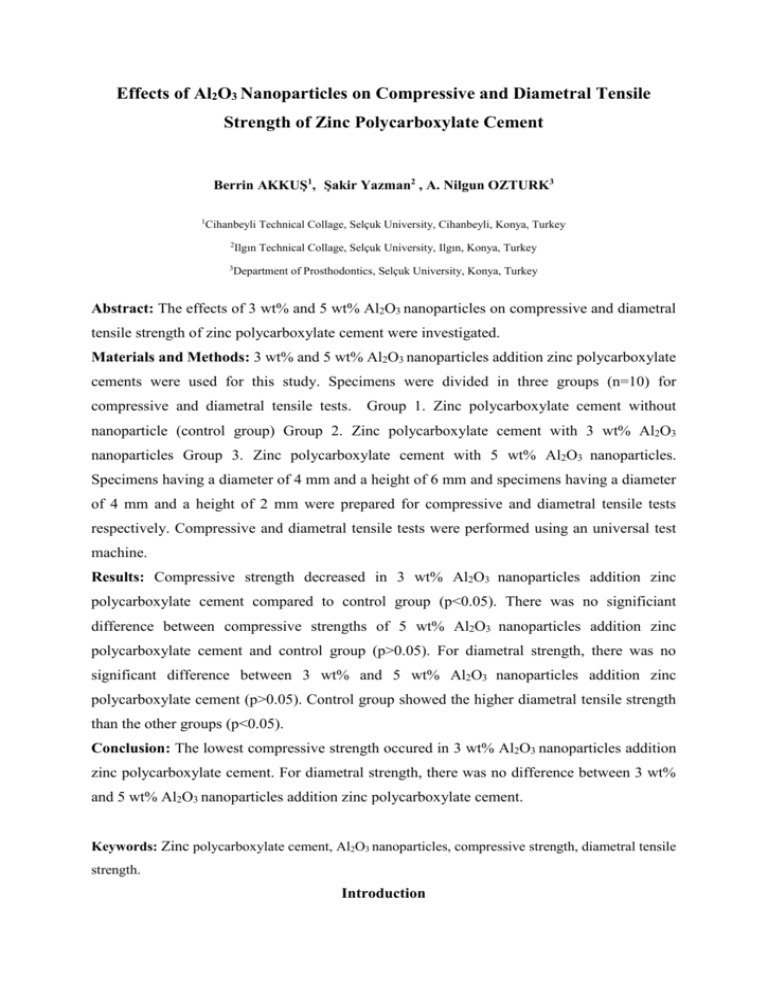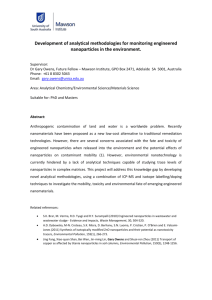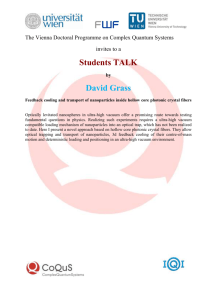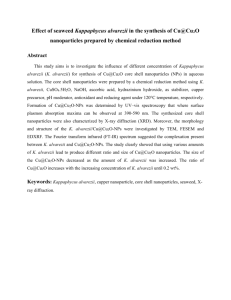Effects of Al 2 O 3 Nanoparticles on Compressive
advertisement

Effects of Al2O3 Nanoparticles on Compressive and Diametral Tensile Strength of Zinc Polycarboxylate Cement Berrin AKKUŞ1, Şakir Yazman2 , A. Nilgun OZTURK3 1 Cihanbeyli Technical Collage, Selçuk University, Cihanbeyli, Konya, Turkey Ilgın Technical Collage, Selçuk University, Ilgın, Konya, Turkey 2 3 Department of Prosthodontics, Selçuk University, Konya, Turkey Abstract: The effects of 3 wt% and 5 wt% Al2O3 nanoparticles on compressive and diametral tensile strength of zinc polycarboxylate cement were investigated. Materials and Methods: 3 wt% and 5 wt% Al2O3 nanoparticles addition zinc polycarboxylate cements were used for this study. Specimens were divided in three groups (n=10) for compressive and diametral tensile tests. Group 1. Zinc polycarboxylate cement without nanoparticle (control group) Group 2. Zinc polycarboxylate cement with 3 wt% Al2O3 nanoparticles Group 3. Zinc polycarboxylate cement with 5 wt% Al2O3 nanoparticles. Specimens having a diameter of 4 mm and a height of 6 mm and specimens having a diameter of 4 mm and a height of 2 mm were prepared for compressive and diametral tensile tests respectively. Compressive and diametral tensile tests were performed using an universal test machine. Results: Compressive strength decreased in 3 wt% Al2O3 nanoparticles addition zinc polycarboxylate cement compared to control group (p<0.05). There was no significiant difference between compressive strengths of 5 wt% Al2O3 nanoparticles addition zinc polycarboxylate cement and control group (p>0.05). For diametral strength, there was no significant difference between 3 wt% and 5 wt% Al2O3 nanoparticles addition zinc polycarboxylate cement (p>0.05). Control group showed the higher diametral tensile strength than the other groups (p<0.05). Conclusion: The lowest compressive strength occured in 3 wt% Al2O3 nanoparticles addition zinc polycarboxylate cement. For diametral strength, there was no difference between 3 wt% and 5 wt% Al2O3 nanoparticles addition zinc polycarboxylate cement. Keywords: Zinc polycarboxylate cement, Al2O3 nanoparticles, compressive strength, diametral tensile strength. Introduction Cements are essentially ceramic materials; in which the ceramic powders convert into solid via a chemical reaction. Inorganic or organic acids initiate setting reaction in the case of dental cements; which found a variety of applications in dentistry. The main utilizations of cements in dentistry are for cavity lining, luting applications and as more dedicated products for sealing root canals as part of a course of endodontic treatment [1]. Zinc polycarboxylate and glass polyalkenoate (glass ionomer) cements are two types of polyelectrolyte cements, which are widely used as adhesives in dentistry. They are the only materials currently available that are capable of chemically bonding to dentine and enamel. Due to their hydrophobicity, they can wet dentine and enamel surfaces, which is an important requirement of any adhesive or dental material [2] . In restorative dentistry, there has also been a growing interest in using nanoparticles to improve properties of dental restoratives [3]. There were several studies performed to investigate the properties of dental cements added different nanoparticles. The addition YbF3 (ytterbium fluoride) and BaSO4 (barium sulphate) nanoparticles (1, 2, 5, 10, 15 and 25% (w/w)) to commercial glass-ionomer cement decreased the compressive strength [4] . Compressive strength significiantly increased in 3% (w/w) TiO2 nanoparticles addition glass ionomer compared to control group, there was no significiant difference between 5% (w/w) TiO2 nanoparticles addition glass ionomer and control group. Compressive strength significiantly decreased in 7% (w/w) TiO2 nanoparticles addition glass ionomer [5] . Significiant variation didn’t occur in compressive strength of 1 wt% TiO2 nanoparticles reinforced glass ionomer cement. Compressive strength increased in 3 wt% TiO2 nanoparticles reinforced specimen and more increased in 5 wt% TiO2 nanoparticles reinforced specimen. Low compressive strength occured in 10 wt% nanoparticles reinforced TiO2 specimen. Diametral tensile strength in 5 wt% TiO2 nanoparticles reinforced specimen was higher than the other TiO2 nanoparticles reinforced specimens [6] . Compressive strength of 3 wt% was the highest in 1, 2, 3 and 4 wt% forsterite nanoparticles additon glass ionomer cements. Diametral tensile strength of 1 wt% forsterite nanoparticles additon glass ionomer cement was the highest in 1, 2, 3 and 4 wt% forsterite nanoparticles additon glass ionomer cements [7]. The effects of 3 wt% and 5 wt% Al2O3 nanoparticles on compressive and diametral strength of zinc polycarboxylate cement were investigated in this study. Materials and Method Specimen Preparation Al2O3 nanoparticles addition zinc polycarboxylate cements were used for this study. 3 wt% and 5 wt% Al2O3 nanoparticles were added to zinc polycarboxylate cement. Manufacturing process were shown in Figure 1. Materials and manufacturers used in this study were given in Table 1. Specimens were prepared in 4 mm of diameter and in 6 mm of height for compressive test using teflon mold. For diametral tensile test, specimens were prepared in 4 mm of diameter and in 2 mm of height using teflon mold. Specimens were divided in to three groups for every test. Every group consisted of ten specimens. Group 1. Zinc polycarboxylate cement without nanoparticle (control group), Group 2. Zinc polycarboxylate cement with 3 wt% Al2O3 nanoparticles, Group 3. Zinc polycarboxylate cement with 5 wt% Al2O3 nanoparticles. Compressive Test Compressive tests were performed for determine compressive strength of specimens. Tests were performed at 1 mm/min. cross head speed using by an universal test machine. Compressive load values were recorded until specimen broke. The compressive strengths of specimens were calculated using Equation 1. Where σ is compressive strength (MPa), F is compressive load at fracture (N), d is diameter of specimen (mm). 4F σ = πd2 Eq. 1 Diametral Tensile Test Diametral tensile tests were performed at 1 mm/min. cross head speed using an universal test machine. The diametral strengths of specimens were calculated using Equation 2. Where σ is diametral tensile strength (MPa), F is diametral load at fracture (N), d is diameter (mm) and h is height of specimen (mm). 2F σ = πdh Eq. 2. Statistical Analysis Statistical analysis was performed with Kolmogorov-Smirnov test of normal distribution an one-way ANOVA followed by Tukey's honestly significant difference (HSD) test with a general linear model procedure in SSPS17.0 (SPSS Inc., Chicago, USA). One-way ANOVA followed by Tukey's HSD test was used with in each group to compare effectiveness of different concentrations of reinforcement. A significance level of 0.05 was used for statistical tests. Results and Discussions In this study the comparison of compressive and diametral tensile strength was done between the control group and the specimens containing different concentrations of Al2O3 nanoparticles. The compressive and diametral tensile strengths of three group specimens calculated and deviation values were determined with statistic analysis. These values were shown in Table 2 and Table 3. One-way analysis of variance showed a significant difference between mean values of compressive strength (P=0.000). Statistical analysis using the posthoc Tukey HSD significant differences test revealed that although compressive strength decreased in 3 wt% Al2O3 nanoparticles addition cement (Group 2) (p<0.05), there were no significant difference between control group (Group 1) and 5 wt% Al2O3 nanoparticles addition cement (Group 3) (p>0.05). Highest mean compressive strength was observed in Group 1 and Group 3, while the lowest was seen in Group 2 (Fig 2). For diametral strength, there was no significant difference between 3 wt% (Group2) and 5 wt% (Group3) Al2O3 nanoparticles addition zinc polycarboxylate cement (p>0.05). Control group (Group1) showed the higher diametral strength than the other groups (p<0.05) (Fig3). Prentice et al. 2006 added YbF3 (ytterbium fluoride) and BaSO4 (barium sulphate) nanoparticles (1, 2, 5, 10, 15 and 25% (w/w)) to commercial glass-ionomer cement. The effects of ytterbium fluoride and barium sulphate nanoparticles on strength and reactivity of commercial glassionomer cement were investigated. Woking time, initial setting time, compressive strength and surface hardness were examined. To add YbF3 and BaSO4 nanoparticles to glass-ionomer cement decreased the compressive strength. Elsaka et al. 2011 added 3%, 5% and 7% (w/w) TiO2 nanoparticles to convetional glassionomer. Fracture toughness, compressive strength, microtensile bond strength, flexural strength, surface microhardness, antibacterial activity, fluoride release and setting time were investigated. Compressive strength significiantly increased in 3% (w/w) TiO2 nanoparticles addition glass ionomer compared to control group, there was no significiant difference between 5% (w/w) TiO2 nanoparticles addition glass ionomer and control group. Compressive strength significiantly decreased in 7% (w/w) TiO2 nanoparticles addition glass ionomer. Khademolhosseini et al. 2012 investigated the mechanical properties of TiO2 and Al2O3 nanoparticles reinforced glass ionomer cements. Compressive strength, diametral tensile strength and microhardness were determined. Significiant variation didn’t occur in compressive strength of 1 wt% TiO2 nanoparticles reinforced glass ionomer cement. Compressive strength increased in 3 wt% TiO2 nanoparticles reinforced specimen and more increased in 5 wt% TiO2 nanoparticles reinforced specimen. Low compressive strength occured in 10 wt% TiO2 nanoparticles reinforced specimen. Diametral tensile strength in 5 wt% TiO2 nanoparticles reinforced specimen was higher than the other TiO2 nanoparticles reinforced specimens. Sayyedan et al. 2014 investigated the effects of 1 wt, 2 wt, 3 wt and 4 wt% forsterite nanoparticles on mechanical properties of glass ionomer cements. Forsterite nanoparticles were produced by a sol-gel process. Three-point flexural strength, diametral tensile strength, and compressive strength were determined. Compressive strength was the highest in 3 wt% forsterite nanoparticles additon glass ionomer cement . Diametral strength was the highest in 1 wt% forsterite nanoparticles additon glass ionomer. Vanajassun et al. 2014 added 3% w/w ZnO nanoparticles to conventional glass-ionomer cement. Antibacterial and mechanical properties of nanoparticles addition glass-ionomer cements were determined. Agar diffusion, compressive strength and shear bond strength tests were performed. Significiant difference didn’t occur between mean compressive strengths of control group (84.096 MPa) and 3% w/w ZnO nanoparticles addition group (84.462 MPa). Conclusions The effects of Al2O3 nanoparticles on compressive and diametral tensile strength of zinc polcarboxylate cement were investigated. According to test results the following conclusions found: 1. Compressive strength decreased in 3 wt% Al2O3 nanoparticle addition cement compared to control group. 2. There was no significiant difference between compressive strengths of 5 wt% Al2O3 nanoparticles addition cement and control group. 3. There was no significiant difference between diametral tensile strengths of 3 wt% and 5 wt% Al2O3 nanoparticles addition cement. References [1] McCabe, JF. Walls, Angus, WG. “Applied Dental Materials”. Chp.27,30,Chp.24, Blackwell Publishing Ltd, Iowa, USA. 2008. [2] Wilson, A. Prosser H, Powis, D. “Mechanism of Adhesion of Polyelectrolyte Cements to Hydroxyapatite”. Journal of Dental Research. 1983;62:590-592. [3] Mitra, SB. Wu, D. Holmes, BN. “An Application of Nanotechnology in Advanced Dental Materials” . J. Am.Dent. Assoc. 2003;134(10):1382-1390. [4] Prentice, LH. Tyas, MJ. Burrow, MF. “The Effect of Ytterbium Fluoride and Barium Sulphate Nanoparticles on the Reactivity and Strength of a Glass-Ionomer Cement” Dental Materials. 2006; 22:746-751. [5] Elsaka, SE. Hamouda, IM. Swain, MV. “Titanium dioxide Nanoparticles addition to a Conventional Glass-Ionomer Restorative: Influence on Physical and Antibacterial Properties”. Journal of Dentistry. 2011;39:589-598. [6] Khademolhosseini, MR. Barounian, MH. Eskandari, A. Aminzare, M. Zahedi, AM. Ghahremani, D. “Development of New Al2O3/TiO2 Reinforced Glass-Ionomer Cements (GICs) Nano-Composites”. Journal of Basic and Applied Scientific Research. 2012;2(8): 7526-7529. [7] Sayyedan, FS. Fathi, MH. Edris, H. Doostmohammadi, A. Mortazavi, V. Hanifi, A. “Effect of Forsterite Nanoparticles on Mechanical Properties of Glass Ionomer Cements”. Ceramics International. 2014;40:10743-10748. [8] Vanajassun P, P. Nivedhitha, MS. Nishad, NT. Soman, D. “Effects of Zinc Oxide Nanoparticles in Combination with Conventional Glass Ionomer Cement: In Vıtro Study”. Advances in Human Biology .2014;4(3):31-36. Fig. 1. Manufacturing process Table (1): The materials and manufacturers Material Manufacturer Zinc Polycarboxylate cement (Poly-F Plus) GERMANY Al2O3 nano powder ( 99.5% pure, powder size 40-50 nm ) MKNANO, Canada Table 2. Mean compressive strengths and standard deviations of groups Groups Mean compressive strength (MPa) Standard deviation Group 1 (without nanoparticle) 34.06 11.64 Group 2 (3 wt% Al2O3 nanoparticle) 17.61 2.58 Group 3 (5 wt% Al2O3 nanoparticle) 27.51 6.49 Table 3. Mean diametral tensile strengths and standard deviations of groups Groups Mean diametral tensile strength (MPa) Standard deviation Group 1 (without nanoparticle) 6.78 0.72 Group 2 (3 wt% Al2O3 nanoparticle) 4.71 0.97 Group 3 (5 wt% Al2O3 nanoparticle) 5.13 1.14 50 45 40 35 30 25 20 15 10 5 0 Group 1 Group 2 Group 3 Fig 2. The graphics of mean compressive strengths of groups 8 7 6 5 4 3 2 1 0 Group 1 Group 2 Group 3 Fig 3. The graphics of mean diametral strengths of groups








